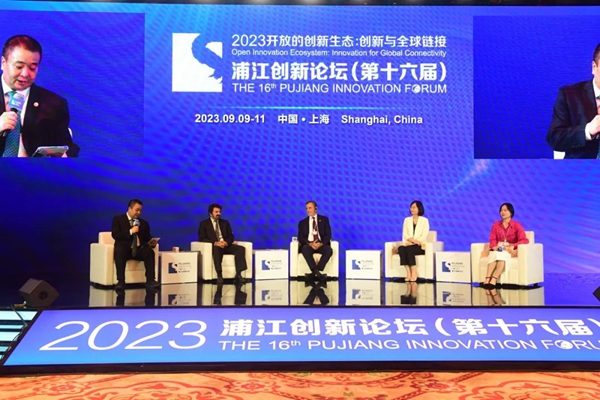Pujiang Innovation Forum calls for strengthening intl scientific collaboration

The 2023 Pujiang Innovation Forum takes place in Shanghai with theme of "Open Innovation Ecosystem: Innovation for Global Connectivity". [Photo/WeChat ID: sh_stcsm]
The 2023 Pujiang Innovation Forum was recently held in Shanghai, featuring discussions on the importance of international scientific collaboration and the establishment of international innovation networks.
Various topics were explored, including large-scale international scientific collaboration projects, open science innovation, and the transformation of scientific and technological achievements into transnational industrial applications.
Attendees also focused on the formulation of international cooperation rules and the need to address inequalities in international collaboration. The goal is to confront common challenges faced by humanity and promote global sustainable development.
One notable example mentioned during the forum involved Chinese scientists making breakthroughs in basic research and a Swiss research team developing relevant technologies. This collaboration led to the application of water and carbon dioxide in the preparation of "solar aviation fuel," achieved through cross-border research and technological relay involving two companies.
During the plenary meeting on Sept 10, CEO Kumsal Bayazit from Elsevier highlighted the significance of international scientific cooperation using this case as an example.
China needs unique innovations in big international scientific projects
Pietro Barabaschi, director-general of the International Thermonuclear Experimental Reactor (ITER) program, stated that ITER is a large-scale international scientific project that involves seven member states and regions, including China, Russia, the European Union, the United States, Japan, South Korea, and India. These countries and regions represent half of the world's population and 80 percent of the world's industrial capacity.
Barabaschi said that the components of the tokamak reactor, used for controlled nuclear fusion, are transported from various parts of the world to laboratories in the south of France for assembly. He emphasized the need for scientific expertise and engineering support from around the world.
Barabaschi also revealed that Chinese scientists and engineers have played a vital role in ITER. They have contributed the first magnet, electrical components, system structural components, gas injection system, diagnostic system, and more. Additionally, over 140 Chinese engineers have participated in the assembly of ITER's core machine.
China's Big Science Program also prioritizes international cooperation. For example, the Design of International Human Phenome Group Project (HPP) led by Jin Li, academician of the Chinese Academy of Sciences, aims to study not only Chinese groups but also people from other continents. Its long-term objective is to evolve into a large international scientific program. Jin said the project has featured international conferences and established an international cooperation group, emphasizing the sharing and openness of data to avoid policy and security risks.
Xu Donglian, an associate professor from the Tsung-Dao Lee Institute at Shanghai Jiao Tong University, highlighted the importance of uniqueness and openness in international scientific and technological cooperation.
Xu's experience participating in international projects, such as neutrino research in the IceCube Neutrino Observatory and site selection for China's next-generation neutrino telescope, has shaped her perspective.
"To participate in international scientific cooperation, teams must have their own unique innovations in their research topics in order to attract attention from international peers," Xu said. "Chinese scientists should be more open, active, and confident in connecting with international peers."

 Print
Print Mail
Mail




